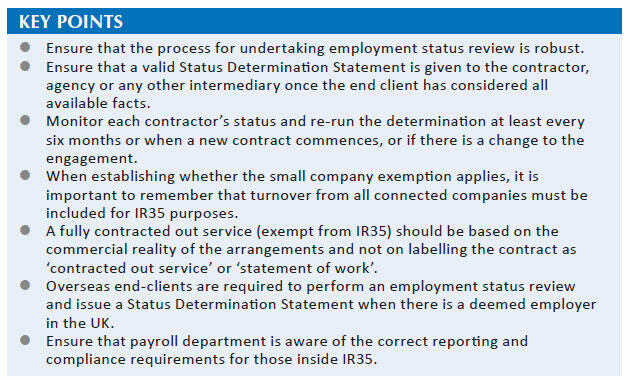A private matter

Nick Bustin and Dinesh Pancholi review the impact of extending IR35 to the private sector
Key Points
What is the issue?
The introduction of the off -payroll working legislation in the private sector from 6 April 2021 meant that medium and large businesses became responsible for determining the deemed employment status of workers engaged via an intermediary.
What does it mean for me?
It was anticipated that 60,000 private end client businesses would be in scope of IR35 rules, as would 20,000 agencies providing workers to medium or large businesses.
What can I take away?
It is imperative that businesses have robust controls, processes and governance in place to demonstrate that reasonable care has been taken in any employment status review of a contractor.
The introduction of the off-payroll working legislation in the private sector from 6 April 2021 meant that medium and large businesses became responsible for determining the deemed employment status of workers engaged via an intermediary. As a result, businesses need robust controls, processes and governances in place to comply with their new responsibilities. Businesses need to understand the steps they should take to remain compliant and how HMRC is likely to police these rules.
Background
The legislation popularly known as IR35 was introduced in 2000 to counter the rise of workers providing their services through an intermediary, typically a limited company (personal service company), instead of being employed by the engager. Its aim was to ensure that where a deemed employment relationship was present, income tax and Class 1 NICs would be deducted from the fees payable to the worker.
When IR35 was first proposed, the onus was to be placed on the engager to abide by the legislation, but this promptly changed to the personal service company before the legislation within the Finance Act 2000 was enacted. Over 20 years later, we have gone full circle. Where the engager is a medium or large business, they are now responsible for considering whether the legislation needs to be applied.
IR35 is hugely unpopular with contractors, and many have felt that it should be abolished. Although its operation has been reviewed multiple times, the government contends that abolishing IR35 would pose too great a risk to the Exchequer. HMRC figures showed that up to 90% of personal service companies were non-compliant before the extended legislation was introduced. Furthermore, the use of personal service companies by senior staff in the public sector was one of the factors which prompted the government to introduce the updated IR35 legislation within the public sector in 2017, with the latest changes, effective from 6 April 2021, applying to all medium and large private sector businesses.
Private sector changes
HMRC collected £550 million in the first two years of IR35 being extended within the public sector, including significant sums from various departments throughout Whitehall. HMRC expects to collect a further £2.9 billion by 2024, so it is unsurprising that IR35 was extended into the private sector too.
The private sector version of the legislation was founded on the rules already in place within the public sector. However, the exclusion of small businesses from the need to operate the legislation is helpful but does present several challenges.
The small employer criteria for IR35 purposes are taken from the Companies Act 2006, and a company is considered a ‘small company’ if it satisfies two of the following conditions:
- an annual turnover of no more than£10.2 million;
- a balance sheet total of no more than£5.1 million (the total amounts shown as assets in the company’s balance sheet before deducting any liabilities); and
- no more than 50 employees.
The key features of the extended IR35 legislation include:
- The end client is required to review the employment status of the worker.
- The engager (the fee payer) is responsible for accounting and paying the income tax and NIC via PAYE if the contract is inside IR35.
- The end client must provide a Status Determination Statement to the worker and the intermediary, setting out its conclusions for the decision and that it has taken reasonable care in reaching that decision. Unless and until the Status Determination Statement has been given to all relevant parties in accordance with the statutory requirements, the end client rather than the fee payer remains liable for any income tax and NIC liabilities.
- There is an appeal process should the worker or the fee payer not agree with the client’s decision.
- The end client then has 45 days to address the appeal and notify the worker and/or the fee payer. If the end client fails to comply, then after the end of 45 days, the end client rather than the fee payer becomes liable for any income tax and NIC liability.
However, HMRC can recover unpaid tax and NIC from any ‘relevant person’, including anyone in the payment chain above the fee payer. Consequently, everyone in the labour supply chain has compliance responsibility. In our experience, identifying the underlying facts connected with the engagement will help to resolve any disputes within the resolution process.
Anticipated impact on businesses and contractors
In the policy paper ‘Off-payroll working rules from April 2021’ (see bit.ly/ 3k20hCs), published on 3 March 2021, the government set out its assessment of the legislation’s impact on individuals and businesses. No significant macroeconomic impact was anticipated. A one-off impact of £19.7 million was forecast, followed by a positive continued impact due to cost savings.
Measures would impact 180,000 contractors who would otherwise be employees if engaged directly rather than via a personal service company. It was anticipated that 60,000 private end client businesses would be in scope of IR35 rules, as would 20,000 agencies providing workers to medium or large businesses.
Where the engager is a medium or large business, they are now responsible for considering whether the legislation must be applied.
The impact on end clients could be significant, but experiences will be varied with some realising savings through reduced administration and compliance requirements, especially the 240,000 personal service companies that would no longer be required to determine status. In some cases, there would be savings on other compliance costs, such as preparing corporation tax returns and company accounts and filing these with Companies House.
How has this worked in practice?
According to the Association of Independent Professionals, since the introduction of the extended IR35 legislation in the private sector over 35% of UK contractors have either become permanent employees of the engager, or have retired, moved to work overseas or are ‘simply not working’ (see bit.ly/ 3mGQ5B3). Of those that remain, 34% are now working via unregulated umbrella companies, and another 36% are working through engagements deemed to be inside IR35.
Importantly, workers who fall within scope of the legislation do not automatically become employees of the engager or fee payer. However, as recent cases have shown, individuals could qualify for ‘worker’ status under employment law, which does bring some employment rights (see, example, Uber BV v Aslam [2018] EWCA Civ 2748). Furthermore, many contractors have seen their net income fall by 30% to 40%. The decrease in earnings could be attributed to, for example, non-tax deductible expenses, employee NIC and employer NIC costs being passed on by the umbrella companies via a reduced day rate.
The increase in those deemed to be inside IR35 could be attributed to engagers making blanket employment status determinations. We have also seen instances where end clients will either not engage with contractors or insist that they use an agency or an umbrella company if they continue working together. Fundamentally, this could be a consequence of insufficient resources to review all engagements, no central point of control to monitor all new engagements, a desire to minimise risk or insufficient awareness across the engager’s business.
This may go some way to explain some of the labour shortages, especially in the logistics sector. This prompted a question in Parliament on how the government was addressing this issue. Its response was that it had commissioned an independent report into the short-term impacts of the reform in the private sector, inviting contributions by 15 November 2021 (see bit.ly/3GOEat2).
HMRC policing
HMRC issued a briefing on 15 February 2021 (see bit.ly/3COHYbq) where it stated that it will support organisations to comply with changes to IR35 rules.
It also confirmed that a specialist team will carry out IR35 compliance activity. We have already seen businesses in the energy and finance sectors being targeted for IR35 compliance checks, which will no doubt be extended to other sectors.
HMRC has said that it would take a ‘light touch’ approach, including no penalties levied during the first year unless there is deliberate evasion – the focus being on helping businesses to comply.
All businesses should establish an employment status policy which clearly sets out the process, controls and governance. Mitigation action points
All businesses should make sure that they establish an employment status policy which clearly sets out the process, controls and governance. In addition, organisations should ensure that all relevant stakeholders have employment status training so they understand the impact on the business should an incorrect status decision be made.
Organisations must also complete due diligence on the labour supply chain compliance. They must also be aware that HMRC has the power to shift tax and NIC liabilities up and down the labour chain where there has been non-compliance. Typical checks could include the trade history of the agency or labour supplier, whether they are operating PAYE, etc.
If an umbrella company is used, it is worth having careful checking processes in place, including reviewing the contractor’s payslip to ensure that the umbrella is being compliant. A regular review pattern is recommended. Organisations should also check how contracts work in practice. There can be a clear contract for services (i.e. self-employed) but the terms of the arrangement must be reflected in practice.
Contractors and businesses intending a self-employed relationship should consider whether it is appropriate to include the following within the contracts:
- there is no right of control over the contractor;
- there is a substitution clause
- (and if the contractor has provided a substitute during the contract, even better);
- the contract is with the personal service company, not the worker, and does not mention a named person; and
- there is no moving from task to task (any new tasks requested should be separately negotiated).
Contractors should not have any line management responsibility and should not appear on the business’s organisation chart, have a company email address (unless there is a business need, such as for reasons of confidentiality) or business card, use company facilities or be invited to staff functions, and there should be no exclusivity. Furthermore, the contractors should provide their own equipment (unless they need to work on engager facilities) and pay for their own training.
Although the government has commissioned research into the impact of the legislation in the private sector, the cynics amongst us may think that nothing will change. This is due in part to the government’s intention of ensuring equality between employees and those contractors who work like employees but via their personal service company, as well as the revenue generated by IR35 in the public sector and the large deficit in the government finances.
It is imperative that businesses have robust controls, processes, and governance in place to demonstrate that reasonable care has been taken in any employment status review of a contractor. Equally important is the education of all relevant stakeholders in the organisation, so the employment status review of the contractor population is undertaken correctly and all IR35 compliance requirements are met.



